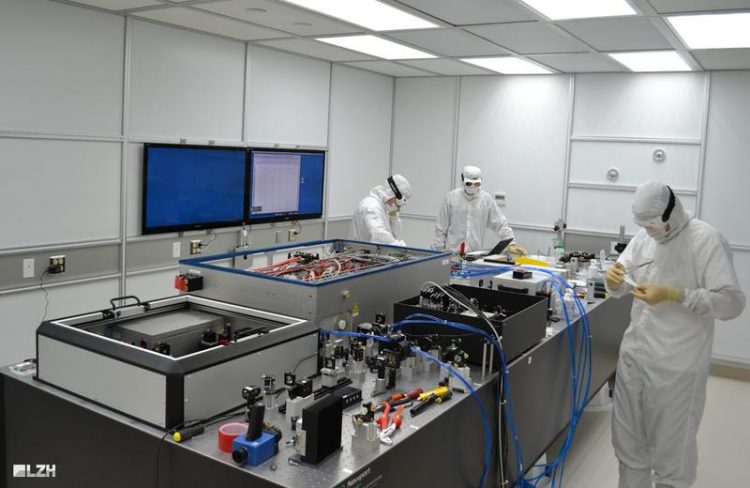Milestone in physics: gravitational waves detected with the laser system from LZH

Installation of the LZH lasers in the LIGO cleanroom, Livingston (US). LZH
The resulting gravitational wave was measured already in September 2015; yesterday, the evaluation of the data was published in the Physical Review Letters and presented to the world press.
For more than ten years, the AEI and the Laser Zentrum Hannover e.V. (LZH) have put R&D efforts into the development of laser systems for the LIGO (Laser Interferometer Gravitational Wave Observatory) gravitational wave detectors.
The lasers of the LIGO detectors were jointly manufactured and integrated into the US observatories as a ready-to-run system by the LZH, the AEI and the LZH spin-off company neoLASE. The gravitational wave detected now was recorded by the Enhance LIGO (eLIGO) model.
The Advanced LIGO (aLIGO) systems that were put into operation in the meantime have a five times higher output power compared to the previous lasers. Under these circumstances, chances to detect further gravitational waves are significantly higher.
With this high-tech measurement instrument, a reliable basis was created for future research in gravitational physics in Hannover and worldwide.
AEI press release: www.aei.mpg.de/gwdetection
LIGO press release: www.ligo.org/news/media-advisory.php
http://www.lzh.de/en/publications/pressreleases/2012/anotherhighpowerlaserforthe…
Media Contact
All latest news from the category: Physics and Astronomy
This area deals with the fundamental laws and building blocks of nature and how they interact, the properties and the behavior of matter, and research into space and time and their structures.
innovations-report provides in-depth reports and articles on subjects such as astrophysics, laser technologies, nuclear, quantum, particle and solid-state physics, nanotechnologies, planetary research and findings (Mars, Venus) and developments related to the Hubble Telescope.
Newest articles

A universal framework for spatial biology
SpatialData is a freely accessible tool to unify and integrate data from different omics technologies accounting for spatial information, which can provide holistic insights into health and disease. Biological processes…

How complex biological processes arise
A $20 million grant from the U.S. National Science Foundation (NSF) will support the establishment and operation of the National Synthesis Center for Emergence in the Molecular and Cellular Sciences (NCEMS) at…

Airborne single-photon lidar system achieves high-resolution 3D imaging
Compact, low-power system opens doors for photon-efficient drone and satellite-based environmental monitoring and mapping. Researchers have developed a compact and lightweight single-photon airborne lidar system that can acquire high-resolution 3D…





















